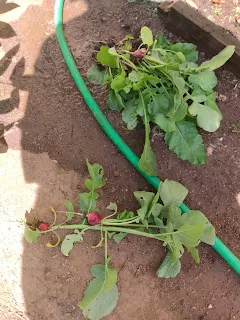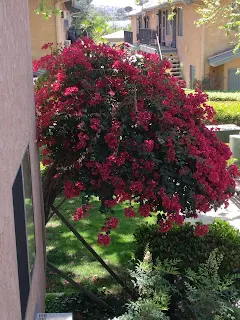It is 12:13 pm and the temperature is 91° (had to look up how to do the degree symbol).
Yes indeed we will be buttoning up really soon here, as the temp is going to climb another few degrees before it starts cooling marginally.
I got out as soon as I could to the garden to water. There are actually seedlings coming up already! Yay!
Hard to see but there's at least two that I didn't notice until I started watering. I think those are marigolds given the location. The shade structure is annoying to pull and put back but it's working at least. Won't need it much after it cools down next week but do need to try and make something more stable and better built.
I noticed one radish was starting to bolt and figured the rest were not worth saving and yanked them all. Biggest radish bulb was maybe a half inch and none of the others had any bulb of note. Now I have more room in front of the tomato for... don't know what. I was walking away from the garden with the clumps in my hand to throw them away and stopped. These are healthy plants... what the heck? Turned around and tossed them on the compost pile. Going to give them a few days before turning it over and burying them.
I did some more research on the potatoes and realized a tall tower may or may not work and if I can't get the materials, I can go sideways. Not looking for bushels of potatoes here but a handful or two would be nice. So I may just try and get some of the peat moss/coir mix and use that with the native dirt about 2-1 for side dressing.
I got pictures of other flowers in bloom, even got one of the roses I saw at the one house down the street.
 |
| Their yard |
 |
| Our yard |
Care and feeding make such a big difference.
This one is actually a nice darker bordered pink. Have no idea what the variety is and I think I'll try and remember my clippers and nip off the hips on that bush to give it some more energy. The buds are darker pink and doing a search came up with a few varieties that looked like it but were obscure or too recent, so honestly have no idea. The picture really doesn't do it justice.
Anyway, other flowers around the complex are coming along, the Martha Washington geranium is blooming a nice purple and compliments the red geraniums in the same bed.
Sorry for the focus, was walking Rocky and he tends to keep moving even if I stop to take a picture. On the same walk and going through the patio I noticed a new plant in a pot on the wall, got closer, got closer and...had to get a picture.
It looked like a Creeping Charlie...sort of... then the details hit me in the face. Too regular color, the leaves were all the same shape, no bites or differences.... someone had put a potted fake plant in the geranium pot. Sigh. Honestly, if I had the money I would be replanting a lot of them and make the place look better rather than have fake plants around. Less work for the gardeners at least and they look good all the time. My hands are twitching to fix things.
Another thing that's blooming is the Tree of Heaven in the neighbors yard. Which I just tried to find a picture of on the net and I want to apologize...it isn't Tree of Heaven! I'm sure I did the research before but forgot.
 |
| Melia azedarach |
Common name, Chinaberry tree or Persian Lilac. No wonder it reminds me of lilac in smell and flower! Let's go to the Wikipedia shall we?
"The main utility of chinaberry is its timber. This is of medium density, and ranges in colour from light brown to dark red. In appearance it is readily confused with the unrelated Burmese teak (Tectona grandis). Melia azedarach – in keeping with other members of the family Meliaceae – has a timber of high quality, but as opposed to many almost-extinct species of mahogany, it is under-utilised. Seasoning is relatively simple, in that planks dry without cracking or warping and are resistant to fungal infection. The taste of the leaves is not as bitter as neem (Azadirachta indica).
The tough five-grooved seeds were widely used for making rosaries and other products requiring beads; however, the seeds were later replaced by plastics. The cut branches with mature fruit are sold commercially to the florist and landscaping trade particularly as a component for outdoor holiday décor. The fruits may persist for some time prior to shattering off the stem or discoloring, which occurs rapidly after a relatively short time in subfreezing weather.
Some hummingbirds like the sapphire-spangled emerald (Amazilia lactea), glittering-bellied emerald (Chlorostilbon lucidus) and planalto hermit (Phaethornis pretrei) have been recorded as feeding on and pollinating the flowers; these only take it opportunistically.[12]
In Kenya the trees have been grown by farmers and used as fodder trees. The leaves can be fed to cattle to improve milk yields and improve farm incomes.[13]
In Australia, particularly the suburbs of Melbourne, the tree is often used in nature strip plantings by local councils. The councils plant such trees for amenity reasons as well as environmental, social and economic benefits.[14]"
And something even more important to know:
"Fruits are poisonous or narcotic to humans[17] if eaten in quantity.[18] However, like those of the yew tree, these toxins are not harmful to birds, who gorge themselves on the fruit, eventually reaching a "drunken" state. The birds that are able to eat the fruit spread the seeds in their droppings. The toxins are neurotoxins and unidentified resins, found mainly in the fruits. The first symptoms of poisoning appear a few hours after ingestion. They may include loss of appetite, vomiting, constipation or diarrhea, bloody faeces, stomach pain, pulmonary congestion, cardiac arrest, rigidity, lack of coordination and general weakness. Death may take place after about 24 hours. Like in relatives, tetranortriterpenoids constitute an important toxic principle. These are chemically related to azadirachtin, the primary insecticidal compound in the commercially important neem oil. These compounds are probably related to the wood and seed's resistance to pest infestation, and maybe to the unattractiveness of the flowers to animals.[citation needed]"
The plant is toxic to cats.[19]
I added the bold and underline for a reason. It is related to the Neem tree surprisingly and is also why it is toxic to some animals, like insects.
Lacy lilac colored flowers and it is so fragrant! Kind of a musky sweet smell that drifts in the evening through our window. If I wanted a sweet smelling tree/bush in my yard and I lived in the PNW, it would be a lilac thank you very much. I think I've seen this for sale as a houseplant which is why it looked familiar in the leaf but not the flowers or fruit.
I'm wondering where the first ones in this neighborhood came from because obviously it only took one to seed everyone else. I've not seen them for sale in the nursery so I'm thinking someone imported it and there you have it. A bird could have eaten a seed and pooped it out but that would have to be something crow sized and crows don't eat those seeds if they can help it. Otherwise they would be swarming the tree out there right now.
Plant mysteries abound!
And in contrast, the Bougainvillea at the bottom of the stairs is looking fantastic! The birds love perching in it and it's just a wonderful show of color right now! I love spring.













No comments:
Post a Comment
Questions? Comments, Concerns...